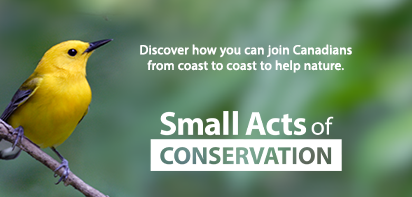New conservation area connects people and nature in the Mauricie region
22 donors mobilized to protect over 270 hectares for nature’s unsung hero
Thanks to the mobilization of 22 donors, along with additional public funding, 271 hectares of biodiverse habitats are now protected by the Nature Conservancy of Canada (NCC) in the Lake Perchaude and the Shawinigan River areas. This territory is part of an invaluable natural corridor for plant and animal species. This newly protected wildlife crossing near La Mauricie National Park is helping at-risk wood turtles thrive and move safely between habitats.
This project was made possible thanks to the extraordinary work of local nature lovers, who organized an impressive fundraising campaign that raised $650,000. Some of these dedicated donors are now volunteers, devoting their time and effort to protecting and conserving this exceptional site. The amount collected, combined with efforts that generated matching funds from both the gouvernement du Québec and the Government of Canada, enabled the protection of the land.
The newly conserved area consists of wetlands, flood plain, aquatic and forest habitats, that are rich in biodiversity. The new wildlife crossing is strategically located near another 300 hectares already protected by NCC, including two sections of the Tortue-des-Bois-de-la-Shawinigan Nature Reserve.
Wetlands found there provide important and valuable ecosystem services for humans through carbon storage, flood prevention and water filtration. Additionally, they are a conservation priority, as they provide vital habitat for many wildlife species.
Road mortality is a major problem for wildlife in this region, particularly for turtle populations. The natural corridor that these protected properties form enables animals to travel safely to feed and mate. It also strengthens the resilience of protected landscapes, spanning the national park and private land in the surrounding area.
Designated as threatened in Canada and vulnerable in Quebec, wood turtles are essential to the overall health of ecosystems. As very few wood turtles reach adulthood, a slight increase in their adult mortality rate due to human activity, such as road collisions, could lead to their population decline. This is why protection efforts in the Mauricie region are essential to the species' recovery.
Acknowledgements
NCC thanks the following donors: Jacques Bois, Mathieu Duchaine and Charlotte Jolicoeur Desroches, Alain Grenier and Thérèse Delisle, Charles André Horth and Brigitte Lepage, the Jacob-Roy family, Jean-Hughes Langlois and Toby Stewart, Etienne Laplante-Courchesne, Martin Lapointe, Alan and Judith Renshaw, Denis Trépanier and Annie Jacques, Chantal Trépanier and four anonymous donors.
NCC would also like to acknowledge support from the Government of Canada, through the Nature Smart Climate Solutions Fund (NSCSF), the Habitat Stewardship Program (HSP) for Species at Risk of Environment and Climate Change Canada and Parks Canada's Landscape Resiliency Program. Also, the gouvernement du Québec who provided funding, through the Partenariat pour les milieux naturels project and the Accelerating Conservation in Southern Quebec project.
With financial support from the gouvernement du Québec, as part of the Accélérer la conservation dans le sud du Québec (ACSQ) project, NCC has begun inventories, developed a management plan and conducted follow-up visits to the territory targeted by this announcement.
Quotes
“It's wonderful to see so many donors and partners coming together in this joint project to protect the natural environments of the Mauricie region. Conservation is truly a team effort. Together, we can now offer the region's species, including wood turtle, an invaluable corridor linked to La Mauricie National Park.” – Claire Ducharme, regional vice-president, Quebec, Nature Conservancy of Canada
“The protection of nature concerns us all and plays an essential role in halting and reversing biodiversity loss, mitigating the climate crisis and recovering species at risk. I would like to thank the Nature Conservancy of Canada, its partners and donors for their commitment and remarkable efforts to conserve healthy, resilient ecosystems. Located close to La Mauricie National Park, these properties form a natural corridor that contributes to the conservation of Mauricie’s rich biodiversity and to the well-being of the community.” – The Honourable Steven Guilbeault, Minister of Environment and Climate Change and Minister responsible for Parks Canada
"Protecting these natural areas is excellent news for the Mauricie region and for all of Quebec. It is thanks to initiatives like this that we are able to protect a wide variety of animal and plant species, as well as their habitats. I want to thank all the partners and donors who have rallied for this cause. It is by working together that we will preserve our rich natural heritage." – Benoit Charette, Minister of the Environment, the Fight against Climate Change, Wildlife and Parks, and Minister responsible for the Laurentides region
To succeed in preserving the most beautiful aspects of nature that we have is our greatest challenge. Conservation is everyone's business, and this project has been particularly unifying for the residents of our small community who are attached to this unique territory. A great sense of pride and accomplishment now drives us all, and we are ready to continue with this momentum. — Denis Trépanier, representative of the donors.
Key facts
- NCC recognizes that these new protected sites are located on the traditional territory of the Atikamekw Nation, historically shared with the W8banaki Nation for the practice of traditional activities. Since time immemorial, the Atikamekw have cared for the habitats and animals that live and thrive here, including wood turtles. We are deeply grateful to the original stewards of these lands and acknowledge the continued presence of Indigenous Peoples in this area.
- More than 80 bird species can be found in the newly conserved area, including several sensitive species, such as Canada warbler (a species likely to be designated vulnerable or threatened in Quebec and threatened in Canada) and bobolink (a species vulnerable in Quebec and threatened in Canada).
- If you see a turtle (dead or alive), you are invited to fill in a form on the Carapace.ca website, an NCC initiative. In doing so, the habitats essential to their survival are targeted so that protection efforts can be better directed.
About us
The Nature Conservancy of Canada (NCC) is the country’s unifying force for nature. NCC seeks solutions to the twin crises of rapid biodiversity loss and climate change through large-scale, permanent land conservation. As a trusted partner, NCC works with people, communities, businesses and government to protect and care for our country’s natural areas. Since 1962, NCC has brought Canadians together to conserve and restore more than 15 million hectares. In Quebec, NCC partners regularly with Conservation de la nature Québec (CNQ), a non-profit organization that is distinct from NCC, to conserve Quebec’s richest natural areas. Together, the two organizations have conserved more than 55,000 hectares of natural areas in the province.
Canada’s Nature Smart Climate Solutions Fund (NSCSF) is a $1.4 billion, ten-year fund (2021–2031) administered by Environment and Climate Change Canada to help conserve, restore, and enhance the management of ecosystems such as wetlands, forests, and grasslands, in order to help tackle the dual crises of climate change and biodiversity loss. The NSCSF will focus on three main objectives: (1) conserving carbon-rich ecosystems at high risk of conversion to other uses that would release their stored carbon; (2) improving land management practices to reduce greenhouse gas emissions; and (3) restoring degraded ecosystems. Overall, these projects will contribute to the reduction of greenhouse gas emissions and increased carbon sequestration, while also providing benefits for biodiversity and human well-being.
One of the Government of Canada’s conservation mandates is the conservation of nature, including the recovery of species at risk. In this regard, the Habitat Stewardship Program administrated by Environnement and Climate Change Canada was established in 2000. It provides funding for projects submitted by Canadians that contribute directly to the recovery objectives and population goals of the species at risk that are listed on Schedule 1 of the Species at Risk Act, or that are designated at risk by the Committee on the Status of Endangered Wildlife in Canada. Environment and Climate Change Canada administers Habitat Stewardship Program funds that support terrestrial stewardship projects, while Fisheries and Oceans Canada is responsible for administering the Habitat Stewardship Program for Aquatic Species at Risk.
The gouvernement du Québec through the Projet de partenariat pour les milieux naturels (PPMN). The PPMN is a four-year grant of more than $53 million from the gouvernement du Québec to the Nature Conservancy of Canada. It has supported for voluntary conservation initiatives to ensure the protection of natural areas of interest by establishing financial partnerships with conservation organizations in the province. The PPMN has helped to develop and consolidate Québec's network of protected areas located on private land.
The Accélérer la conservation dans le sud du Québec (ACSQ) project is a co-funding agreement between the gouvernement du Québec and the Nature Conservancy of Canada (NCC), benefiting Quebec conservation organizations. The project aims to protect and conserve natural habitats of ecological interest, notably through the acquisition of private land, for protected and conserved areas and the establishment of ecological corridors. Through this, the ACSQ will promote the development and sound management of the network of protected areas on private land, as well as public access to nature. The gouvernement du Québec invested $144 million in the ACSQ over five years; this must be matched by NCC and its partners with other funds not provided by the gouvernement du Québec.
The Landscape Resiliency Program is a collaboration between Parks Canada (PC) and the Nature Conservancy of Canada (NCC) that will conserve up to 30,000 hectares of forests, wetlands, shoreline areas and grasslands near Canada’s iconic National Parks. A total of $30 million will be invested from now through March 2026 to strengthen landscape resiliency in these areas and create connected pathways for the movement and dispersal of wildlife. The conservation of these areas will help reverse biodiversity loss and mitigate the impacts of climate change. PC and NCC share a common goal of protecting the ecological integrity of these lands and waters for today and for the future by working with local landowners, partners, Indigenous Nations and communities.
The Quebec Ecological Corridors Initiative (QECI) was launched by the Nature Conservancy of Canada (NCC) in 2017 to accelerate the conservation of natural areas connected by ecological corridors. The initiative is coordinated by NCC and led by a group of 10 organizations. The group offers a collective approach to land use planning and advises provincial and municipal governments, woodlot owners, farmers and other key stakeholders. The group also carries out mobilization, capacity building, recognition and support activities throughout southern Quebec.
Learn More
Follow us on on X (formerly Twitter): x.com/NCC_CNC | x.com/NCC_CNCMedia
Find us on Facebook
- 30 -




